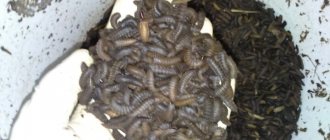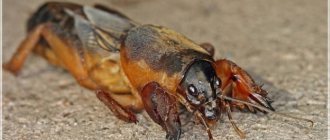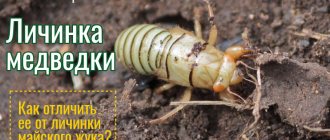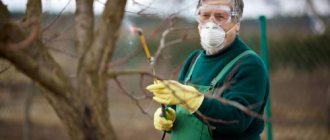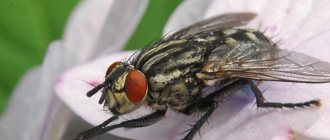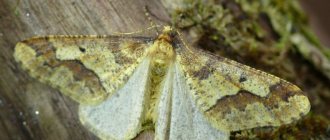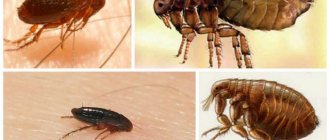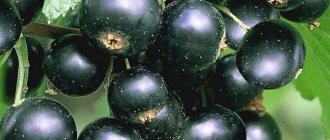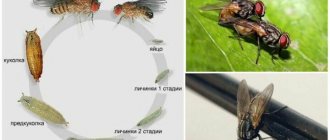How and why flies are bred
This is the story of entrepreneur Igor Istomin, who built a real fly farm. Igor explains why flies are not really disgusting, how larvae help little piglets and chickens survive, and why a small factory for the production of insect larvae should someday appear in every poultry farm.
As a child, I had one strange thing. More precisely, I had a lot of strange things, but now I will tell you only about one. I really liked flies. My parents hung Velcro insect repellents in our country house, and from time to time, half-immobilized, unhappy, and dying flies would fall onto the table. I picked them up and put them in a transparent box with holes for air - it was a hospital. When another insect, despite all my efforts, still died, I seemed to be very upset. I also liked to put a fly on my hand and watch it crawl along it - it felt pleasantly ticklish to my hand. You must have grimaced, reader? That's how my parents grimaced. And they said: “Julia, do you have any idea WHERE they walked with those paws?”
It is generally accepted that adults understand everything better, and children should listen to them without asking unnecessary questions. But when it comes to flies, at five years old I seem to be closer to the truth than my parents.
“You know, Yulia, people very strongly believe in different stereotypes,” Igor Istomin, the founder of a small farm where fly larvae are bred to create environmentally friendly biofeeds and fertilizers, tells me. “When you tell people about flies, they immediately imagine all sorts of sewage, toilets and rot. But, firstly, if it were not for these insects, our planet would long ago have been covered with a many-kilometer layer of corpses, because they would have been processed much more slowly. And in general, research has long proven that there is an antimicrobial environment around every fly.
Yes, this insect climbs through garbage dumps, but then it carefully washes its legs, which have thin chitinous hairs. These hairs secrete a microsecretion that disinfects everything. And in Napoleonic times, fly larvae were used to clean hard-to-heal wounds - they perfectly remove necrotic tissue and keep living tissue intact. Microsecret is rich in immunomodulators, and healing occurs faster. In America, this method is still sometimes used in surgery today.
Until 2014, Igor Istomin was engaged in household appliances, but with the onset of crisis times he decided to sell his business and start some new promising business. Friends invited him to build a small plant for the production of maggots together, and Igor invested money from the sale of the business into this enterprise. “Actually, before, even before I started selling household appliances, I was a swimming coach,” says Igor. - And not bad. So biology was close to me, I was quite good at it. It seemed to me that the production of fish maggots was somehow superficial; hatching larvae could give the world much more than just fish bait. I began to study this topic more and more deeply, my sons helped me, and as a result, by 2015, they and I produced the first experimental batch of excellent feed protein, and in January 2016 we demonstrated it in Moscow at an exhibition at VDNKh.
As Igor Istomin explains, he didn’t have to invent any new technology—nature had already done everything. Flies have been in the world for more than twenty million years - they survived the Ice Age and many other natural disasters, unlike mammoths, dinosaurs and the Mauritian dodo. This means that there is something in the body of this insect that promotes survival.
“In the wild, animals, birds and fish eat something, throw out digestive waste, and eventually die,” explains Istomin. “As soon as this happens, hordes of flies immediately fly to the place of death and lay eggs. And the eggs hatch into larvae that quickly process this waste. At the same time, the larvae themselves become excellent food for other animals, and the processed waste becomes an excellent fertilizer for plants. Nature has already thought of everything for us. We simply took this mechanism and placed it under the roof - we decided to see what would happen if we made our own company out of it.
At any agricultural enterprise, be it a poultry farm or a fish hatchery, quite a lot of waste is generated. For example, the mortality rate of poultry is five to seven percent - chickens periodically die due to weak immunity or break something. There is also always food and plant waste at enterprises, and they all cause a lot of trouble - they need to be stored, disposed of, special acidifiers must be added, so that after two years this waste turns into fertilizer and can be taken out to the fields. If all this is not done, problems with environmental services may arise. As Igor Istomin explains, his “fly farm” can become an ideal example of waste-free production, and then you won’t have to spend money and time on waste disposal at agricultural enterprises.
“We breed a fly called Lucilia Caesar, this is an ordinary green synanthropic carrion fly,” explains Igor. - However, we just call her Lyusya. We have an insectarium with cages where adult flies live and there is constant crossing of different species and generations. On average, each fly lives from twenty-one to twenty-four days, so those insects that now live in our insectarium have never seen the outside world and are noticeably different from those that you meet in nature. For example, they have a much higher egg production, because here, with us, different generations are constantly interbreeding in a closed environment.
ABOUT TWO HUNDRED THOUSAND FLIES LIVE IN EACH CELL OF THE INSECTARY, THERE ARE FIVE SUCH CELLS ON THE FARM, THAT IS, IN TOTAL, THERE ARE ABOUT A MILLION FLIES IN PRODUCTION.
They eat sugar and powdered milk and drink water. Each cage contains a small box—Igor calls it a “lunchbox”—with minced meat inside. “New Technologies” cooperates with a poultry farm, which specially for this purpose gives away those birds that did not manage to survive.
“There are small holes in the lunchboxes,” says Igor Istomin. - Flies are shy. Therefore, they fly there to reproduce and lay eggs on minced meat. Every day a technologist comes, takes away lunchboxes with clutches and puts new ones. And the old ones - with masonry - are transferred to the nursery shop. In the growing shop there are special cabinets with trays where the company’s employees place masonry and add more fresh meat. Then larvae emerge from the eggs and feed on it. During growth, fly larvae emit a lot of ammonia, so each cabinet is connected to ventilation, the air from which, when going outside, passes through a special microbiological filter.
IN FOUR DAYS, EACH LARVA INCREASES THREE HUNDRED FIFTY TO FOUR HUNDRED TIMES, AND ONE GRAM OF LARVA REQUIRES TWO HUNDRED GRAMS OF MEAT. They do not have a stomach, so it would be wrong to say that they eat this meat. They secrete larval juice into the meat, which is rich in enzymes and nutrients. Under their influence, the meat quickly decomposes and turns into mush, and then the larva passes the resulting substance through itself many times. Due to this, it grows, and the resulting substrate is enriched with enzymes and becomes useful.
After three to five days, when the larvae grow, they, together with the substrate obtained from the meat, are taken to a special workshop. To separate the grown larvae from the substrate, everything is dumped together onto a fine mesh - the larvae crawl through it, and the dry fibrous mass, which was once minced meat, remains on the mesh.
Then the substrate is collected in bags and left for a day. At a temperature of 65 degrees it burns out under the influence of anaerobic bacteria. Then it is dried and crushed. “It turns out to be an excellent organic fertilizer,” boasts Igor Istomin. “It kills all kinds of bugs in the soil that eat the roots of plants, and the yield doubles. In this case, it is enough to add just a pinch of such substrate to the ground.
While in one department of the enterprise fertilizer is made from processed meat, in another department the larvae are turned into food: they are processed, cleaned and dried at a temperature of no more than 70 degrees in order to preserve nutrients and not destroy the protein. Then they grind it. The result is fatty flour with a high content of protein and lipid acids - BLK, protein-lipid concentrate. “BLK contains natural polymers melanin and chitin,” says Igor. - They help strengthen the immune system. For example, the most difficult period for piglets is the transition from mother's milk to regular feed. Often the gastrointestinal system of animals that are not yet strong cannot cope, they get sick and die. If seven days before switching to feed you start adding BLK to milk, half a gram for every kilogram of weight, and then add it to the feed for another ten days, the result will be one hundred percent. The piglets will stop getting sick. And if you add a little BLK to the food of a domestic dog or cat, its immunity will improve, it will be easier to shed, and its activity will increase.
Today, in most agricultural production, animals receive protein in the form of fishmeal. But over the past fifteen years, it has risen in price eight times, and the world’s fish reserves are gradually drying up, because it turns out that animals are competing for it with humans. At the same time, the production demand for animal proteins is colossal - in Russia their annual deficit is about a million tons. It turns out that we urgently need to look for alternative sources of this protein. And Igor Istomin believes that he has found such a source. “Imagine if every poultry farm had a small workshop like the one we made at our own,” he says. “You don’t have to pay for disposal, and here, in your own production, you could make excellent food.” This would give both weight gain and a reduction in morbidity. In Russia, such technology began to be invented back in the 70s of the last century, but all this was at the level of scientific research and remained within the framework of laboratories. We are trying to bring this into real life.
True, it turned out that it is not so easy to establish waste-free production in Russia - there is simply no regulatory framework for this. At first, it took a long time to certify the product - the companies that deal with this simply did not know how to work with dried larvae. Then it turned out that according to the law, biological waste must be burned, buried or subjected to heat treatment. No other processing methods are provided. So we have to demonstrate new technology over and over again and prove to everyone that it works.
So far, Igor Istomin’s enterprise remains unprofitable: in order for it to start making a profit, it needs to greatly expand its area and hire more workers. In the meantime, there is only enough capacity to produce pilot batches - they are sent as samples to plants and factories so that they can test the new food and compare it with fishmeal. — Now there are already several enterprises ready to buy BLK from us. Moreover, fishmeal costs from 80 to 120 rubles per kilogram, depending on the quality, and our product costs 100 rubles. That is, it has every chance of displacing flour. But in order for production to not be at a loss for us, we need to produce eight to ten tons of BLK per month, but so far we only get one.
We are looking for investors and really hope to receive a government grant for research. But it’s difficult with investors - you understand, a person is more interested in buying ready-made milk than in a cow that will give this milk. So today we are separated from commerce by approximately 12,000,000 rubles and six months of work. But when everything works out, we want to make something like a showroom - let the factory owners come and see how everything works here, and order us such waste processing modules. We will come and build the same ones at their enterprises - it will be something like a franchise. And the seed fund will continue to be with us. It’s good for us, for enterprises, for nature, and for the state. Finally, Igor Istomin asks me if I have ever seen pickled beetles in jars - in Asia you can buy these in supermarkets, and people eat them from time to time. I answer that I not only saw it, but also tried it - nothing special.
“You see,” Igor sighs. “There, in the East, people have already understood what we cannot understand. After all, excellent protein supplements that are useful for people can be made from larvae. We have several athletes we know who buy our BLK and mix it with honey for breakfast. But these are athletes. But mostly people are afraid to try this. All stupid stereotypes.
Growing technology
Whether you grow larvae for yourself at home or in a large production facility for sale, the technology is the same.
It differs only in the size of the premises, the amount of raw materials and the containers used. Larval production can be divided into several stages:
- Fresh or rotting organic matter is placed in the container. The container itself is placed in a cool, shaded room accessible to the blue blowfly. Other types of flies have smaller larvae.
- After a couple of days, the flies lay eggs in groups on the product.
- The container is closed with a lid with small holes made for air access.
- The larvae begin to grow, and when they reach the desired “marketable” size, they are transferred to sawdust to remove the unpleasant odor.
- After two days, the maggots are transferred again and stored. Keep the larvae at home in the refrigerator. If you miss the moment of moving them to a cold place, the larvae will pupate.
Application in fishing
Black soldier fly maggots are also used in fishing. They are suitable for bait and complementary feeding. Carp, roach, crucian carp, redeye, as well as other river and lake inhabitants are good for larvae. And if maggots are painted yellow or red, they can attract the attention of large predators.
What fishermen say
While exploring the Internet, I came across completely different opinions. I will list the most striking of them:
1) It is often noted that the average weight of fish is slightly higher than when fishing with maggots.
2) “Partial” predators bite well. Chub, ide, rotan, perch. But ordinary peaceful fish too. Just as a percentage. Perhaps the peculiarity of the region can be traced.
3) It also performs well in winter fishing. Bream, large roach and especially perch are responding.
4) Small things do not bite readily. For example, small roach up to 150 grams. Although for each fisherman, such a measure as “magnitude” is individual.
5) In the Siberian region, a positive reaction of grayling is noted.
6) Added as a live component to bait when catching bream.
Other production methods
Growing maggots at home can be simplified even more, and there are also original ways to breed them.
We suggest you read: When wasps sleep in summer. Where do wasps spend the winter and how do they prepare for winter? Video: Review and macro photography of a dangerous insect of a very aggressive, biting wild wasp sitting in a test tube
This type of maggot can be easily made at home or right on the shore of a pond after fishing. Take a plastic bottle and cut it in half into two parts. Pour a layer of sawdust 5-7 centimeters thick into the lower part. Unscrew the cap and insert the top of the bottle into the bottom, neck down.
In this case, the neck should not reach the sawdust by a couple of centimeters. Next, we put a dead fish, a half-eaten egg, sausage or meat at the top and place the “device for producing larvae” in the shade in a secluded place. When we arrive fishing a week later, we take out the structure and select ready-made larvae.
Above the water
This method of growing is also interesting. On a pond you frequent, choose a tree with a branch overhanging the water. Attach a jar with a holey bottom to this branch. Place a fish or piece of meat in the jar.
Hatching maggots will fall into the water and attract fish to this place. While fishing, all you have to do is throw your tackle with maggots on a hook under a branch and catch fish that are accustomed to feeding on larvae. Make new stockings from time to time, then you will not need to take care of the bait all season.
From eggs
The largest larvae for fishing are obtained from raw or rotten eggs. One fisherman aptly described them as “Michurinsky”. The technology for producing giant maggots is very simple, but it is better not to use it at home because of the very specific “fragrant” smell.
- We take a container and pour a layer of sawdust five to ten centimeters into it, for example, a low old saucepan.
- We place the eggs vertically in the sawdust, strengthen them with sawdust so that they do not fall.
- We break the top of the shell and wait for the flies to arrive.
- Each egg hatches 20-30 larvae, but all of them are “Michurinsky”, some of them can get out of the shell into the sawdust.
Breeding fly larvae in honeycombs
Place the cells on both sides of the general structure. This form is economical and effective for the construction of honeycombs. The horizontal diameter of a bee cell is 5.3-5.7 mm (there are about 4 cells per 1 square centimeter), depth is 10-12 mm. The thickness of combs with unsealed brood is on average 22 mm, and after they are sealed up to 25 mm or more. The cell volume is about 0.28 cubic centimeters.
After mating, the female lays fertilized eggs at the bottom of the honeycomb cells, where they remain dormant for 3 days. In the cells of used honeycombs there is food in the form of residues from honey; the larvae will feed on it.
Female fertility
Flies acquire the ability to fertilize the day after their birth. Young females lay about 70 eggs at a time, more mature individuals - up to 120 eggs. Fly eggs are oval, off-white in color, no more than 1 mm in size. They are always located in groups. Photos of fly eggs can be seen below.
Flies at the adult stage live from 14 days to 2 months, depending on climatic conditions. During its life it manages to lay about 2 thousand eggs. They begin to be active in early spring, when the air temperature rises to 10 degrees Celsius. At the end of September and October, with a decrease in climatic indicators, the insect goes into hibernation. Flies, larvae, and pupae overwinter.
Features of the insect
The black soldier fly is a large fly from the soldier fly family (Stratiomyia chamaeleon).
It does not have a clearly defined habitat, as it is found everywhere. The black soldier fly visually does not at all resemble ordinary flies. A feature of the insect is its poorly developed oral apparatus, which is why the fly is only able to drink.
Black soldier fly on a leaf
The main purpose of an adult is procreation, since it is the black soldier fly larvae that are of interest.
Another feature of the fly is sexual dimorphism. This means that there are no characteristic differences between males and females in this species. This also applies to the size of the fly: it largely depends on the amount of food consumed by the larva.
Horseflies
Horseflies are a large family of dipterans (there are about 130 species in the USSR), in which the most famous genera are true horseflies (Tabanus), lacewings (Chrysops) and rainflies (Chrysozona, Haematopota). In the dormitory, horseflies are constantly mixed with gadflies, which are a completely different group of insects.
The true horsefly (Tabanus) in its adult state is well known to everyone. Looks like a large, big-eyed fly. The horsefly quietly lands on the unprotected skin of a person who detects its presence, suddenly feeling a sharp pain from the injection. In hot, dry times, horseflies hover in flocks around horses and cows, tormenting them with their stings. In the north, deer suffer from them. They are sometimes carriers of anthrax and tularemia pathogens.
